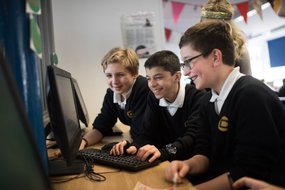
About The Guardian Foundation’s Behind the Headlines: Media Literacy Ambassadors programme
The Behind the Headlines: Media Literacy Ambassador programme, run by the Guardian Foundation, aims to empower young people aged 14 to 18 with the knowledge, skills and confidence to critically analyse media and news and recognise mis- and disinformation. Targeted in schools in areas of socio-economic disadvantage in the Midlands, Greater Manchester, and West and South Yorkshire, it combines direct and peer-to-peer-based learning to support young people’s media literacy.
Commissioned by the Department of Science, Innovation & Technology (DSIT) Media Literacy Programme over the academic years 2023 and 2024, the project provided professionally delivered workshops, teacher training, high-quality resources and ongoing virtual support to train students as ‘Media Literacy Ambassadors’ (MLAs), who then co-delivered media literacy sessions to fellow students.
This external evaluation was conducted by The National Literacy Trust.
Key findings
The programme reached 4,549 students (807 of whom were trained as MLAs) at 31 settings. Based on findings from 791 pre-project and 538 post-workshop surveys and quiz responses from participating students at 28 schools, 153 pre- and 123 post-project quizzes from non-participating (comparison group) students at eight schools, and teacher feedback from 70 surveys and 10 interviews. the evaluation showed:
- The Media Literacy Ambassador programme improved media and news literacy skills. The percentage of participating students able to identify two of three items correctly as real or fake increased from 2 in 5 (39.9%) before to 7 in 10 (68.5%) after the workshop, an increase of 28.6 percentage points (pp). The percentage of non-participating students able to identify two of three items correctly also increased, however, the percentage-point increase (18.4pp) was 10.2pp lower than that observed in the participating group.
- The peer-to-peer model supported reach and consolidated learning. Media Literacy Ambassadors reported stronger media and news literacy skills after co-delivering sessions to peers, with 9 in 10 feeling they had increased skills in thinking critically about news stories. In addition, 3 in 4 MLAs felt they had increased their presentation (76.7%) and communication skills (75.2%).
- Students receiving sessions co-delivered by MLAs found them engaging and reported positive outcomes in relation to media and news literacy and confidence.
Overall, findings suggest that co-delivered workshops were effective in supporting students to learn techniques for evaluating the reliability of news and had a positive impact on media and news literacy attitudes and confidence.
Findings also suggested the project could have a powerful longer-term impact on students’ engagement with media and news. Comments from students included:
I am more open to news and media because I trust that now I can fact-check sources and news. I used to avoid most news altogether because I didn’t know what was true and what wasn’t.
Recommendations
The findings suggest that the Media Literacy Ambassador approach could be an effective way to support media literacy, with the peer-to-peer model supporting greater reach, while embedding learning and having further positive impacts on students’ transferable skills.